Pleated panels hung from rings on a rod hang just to sill level in the parlor of the Winslow Crocker House, built in 1780 in Yarmouth Port, Massachusetts.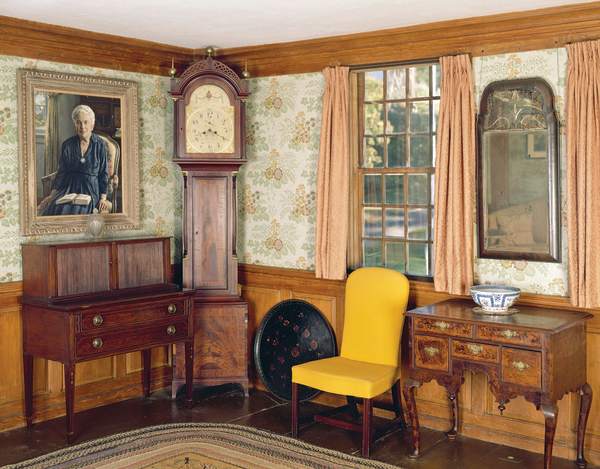
Envisioning the not-quite-right Priscilla curtains of Colonial Revival rooms, or more dauntingly the lavish drapery in historic house museums, owners of pre-1830 houses may shrink from dressing their windows. Good news: Many styles are both authentic and achievable.
Window coverings were, in fact, a rarity until the mid-18th century, found only in the bedchambers of the rich and second in importance to bed curtains. As the century wore on, a prosperous merchant class emerged, eager to fill their new homes with luxury, so curtains began to grace parlors. Not long into the 19th century, middle-class families were able to dress their windows, too.
Unpleated crewelwork panels hang from rings on a rod set into the window frame, dropping to sill level, in an early Connecticut house with decorating interpreted to ca. 1700.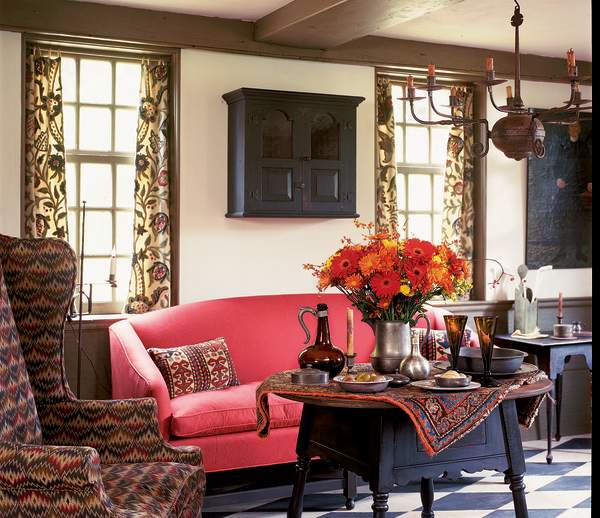
Quality, of course, signaled wealth, and those who could afford it bought imported taffetas, damasks, brocades, and other fashionable fabrics. Thomas Jefferson ordered silk damask for his curtains from France. Textiles weren’t exclusively from abroad, though. Even before the Revolution, specialty weavers were producing native versions of stylish imports. Commercial manufacture of popular printed fabrics began in Philadelphia as early as the 1770s. And since colonial times, households produced their own cloth on spinning wheels and looms.
Simple panels of muslin or homespun were used to soften the window frame and moderate light.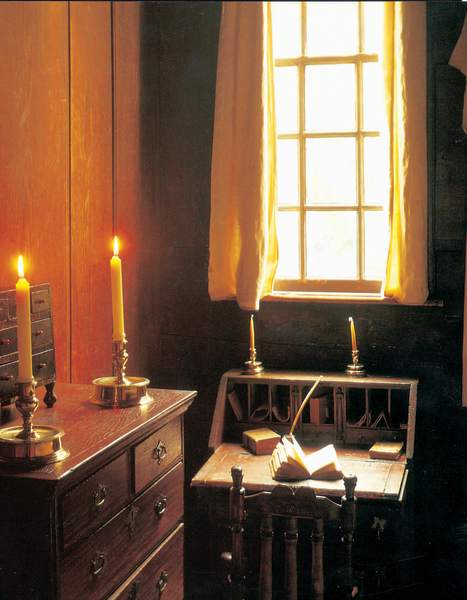
Today’s homeowner should feel free to rummage around in the trunk of America’s drapery-design past to find something that suits. Unless your decorating matches the precise year your home was built (and who knows if the original owners even did that!), you can choose from a variety of options to get a period feeling. Windows wearing anything from a goddess-inspired drape of gossamer silk to serviceable homespun will still be appropriately dressed.
Venetian Blinds
The practical go-to as a window covering in America for centuries: Mount Vernon, Monticello, the Governor’s Mansion at Williamsburg, Independence Hall all had Venetian blinds.
Then as now, 1″ to 3″ wooden slats are hung on woven tape. Both stained and painted blinds have historical precedent. Georgian design favored a clear finish that highlighted the wood’s grain. With the general lightening of Federal interiors, blinds were painted—usually in the same color as the window trim; these were pastel, white, or stone colors. Venetian blinds were prized, too, because they solved the pesky problem of how to cover semi-circular Palladian windows and fanlights. The decorative gravitas of Venetian blinds meant that they were used in the public rooms of a house: parlor, sitting room, and dining room.
Shirred onto a rod, simple panels are drawn up by means of cords to festoon in the Sally Otis bedchamber of the Harrison Gray Otis House (1796) in Boston.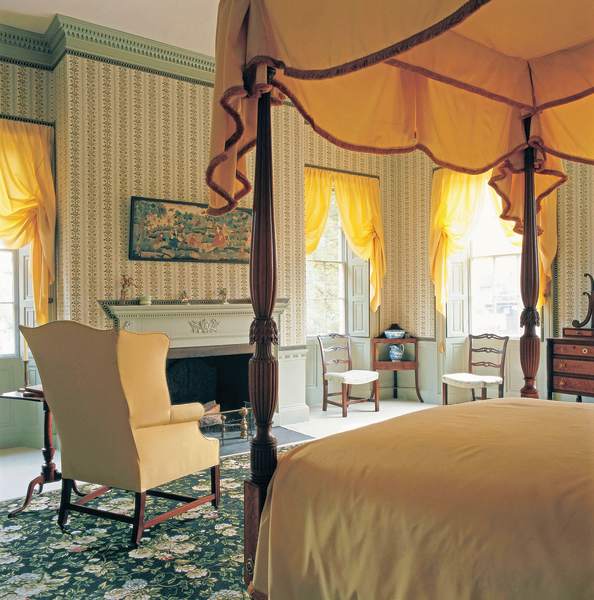
Swags
The basic swag is a perfect blend of elegance and simplicity, just one graceful swoop of fabric draped over a pole at the top of a window frame, or hung from a stiff valance (pelmet). Purely decorative, a swag softens the window geometry. Simple swags may wear a short fringe or be left untrimmed.
When the fabric also cascades down the sides of the windows, the tails are called jabots. Swags or swag-and-jabot combinations may be formal or informal, the look dictated by choice of fabric and trim. In either case this dressing offers little privacy. The public rooms of Georgian homes wore uncomplicated swags that let the sumptuous fabrics speak for themselves. Moving into the Federal era, when lightness and elegance emerged, even simple dressings were bedecked with delicate tassels, tape, and fringe.
The swag or swag-and-jabot was used as a stand-alone window treatment as well as complementary decoration over a pair of curtain panels or Venetian blinds.
Curtain Blinds
Sill- or floor-length, dressed up or down, there is a curtain to match every taste and budget. The earliest curtains were quite plain, tab-top or shirred onto a rod and hung more for warmth than for aesthetics. Their simple charm has stood the test of time.
In a mid-18th-century gambrel half house, what could be simpler than a length of lined fabric swagged over the window header?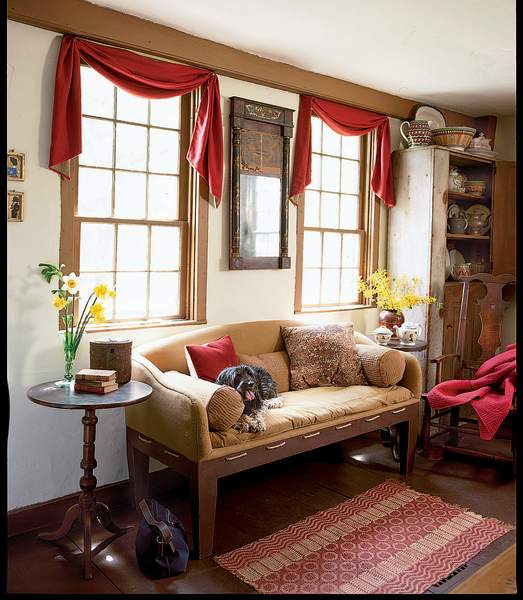
By the second half of the 18th century, simplicity was not paramount in fashionable homes. Curtains became a formal drapery, floor-length and topped with an elegant cornice—usually painted or gilded wood, less often a stiffened fabric with embroidery or appliqué. Curtains were held back by rope tiebacks and ornamented with fringe and tassels. Tassels were so expected, one Philadelphia woman made a career of them: in 1775 Ann King advertised herself as the “first American tossel maker.”
Stiff cornices and pelmets gradually fell out of fashion in late Federal and then Greek Revival homes, replaced by softly swagged valances. Hardware gained importance; thus gilt and brass tiebacks were showcased. Another popular style was curtains hung on a decorative rod from brass rings, with no swags, no cornice, no valance. Handsome yet understated, the idea was presumably easier on the pocketbook, too.
Window dressings of the Greek Revival period epitomized the sentiment “more is more.” Built up in layers, the typical treatment consisted of lightweight under-curtains (also called glass curtains, which were generally fixed to the side), plus curtain panels and a decorative cornice, with a swag or valance. Hardware was increasingly decorative with gilt rosettes and laurel wreaths. Tassels and trimmings were abundant and heavier than ever before. These treatments are not to be undertaken by the faint of heart.
A deep, stationary, box-pleated fabric valance hangs over sill-length curtain panels at the Bump Tavern at the Farmers’ Museum in Cooperstown, N.Y.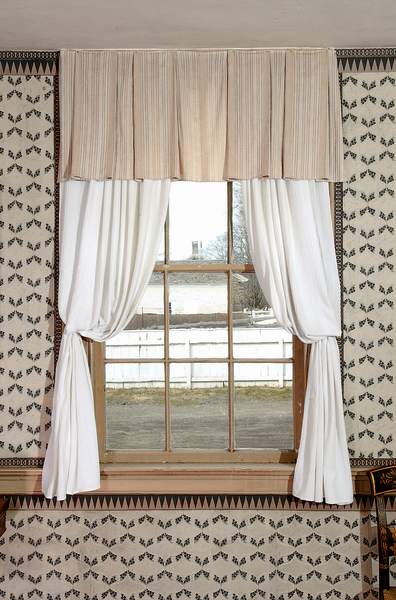
Festoons
The festoon curtain is an ancestor of the balloon shade, and likely inspired by tie-up curtains used on beds. First documented in the 17th century as a “pull-up curtain,” a festoon is basically a panel of fabric pulled up by means of cords to hang in festoons or swags.
Like the swag, a festoon may be more or less formal. Simple festoons, which bear a strong resemblance to contemporary, flat Roman shades, were hung in bedrooms. But the colonial rooms of the wealthy were filled with very full, richly trimmed festoons, which made an impressive display in the tall, narrow sash windows of public rooms. Festoons may be hung alone or topped by a cornice.







